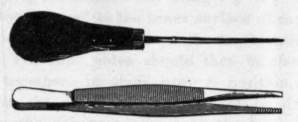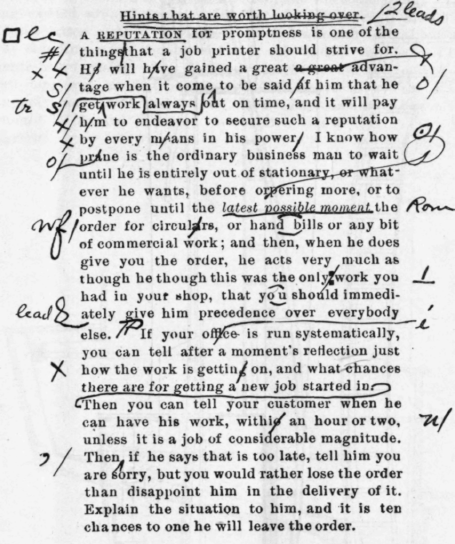Printing For Beginners. VI. Correcting Proof. Proof-reader's Marks
Description
This section is from the book "Amateur Work Magazine Vol3". Also available from Amazon: Amateur Work.
Printing For Beginners. VI. Correcting Proof. Proof-reader's Marks
FREDERICK A. DRAPER.
In the previous chapter, the method of taking proofs was given. As it rarely happens that the composition is without errors of some kind, we will now consider the way to indicate and correct them. Certain signs are used to indicate the different kinds of errors, so that the compositor may know just the correction to be made. They are given, with their explanations in the following list, and by comparing them with the uncorrected and corrected examples, can quickly be committed to memory.

Bodkin And Tweezers proofreader's marks.
Space standing too high, push down.
Insert space.
Less space.
Even spacing.
Close up space entirely.
Change a bad letter.
Turned letter, i. e. upside down.
Dele; take out.
Move over.
Caret; insert letters or words.
An em quad required.
Period.
Comma.
Colon.
Semi-colon.
Apostrophe.
Quotation marks.
Hyphen.
One-em dash.
Two-em dash.
Paragraph.
No paragraph.
Wrong font.
Correction made in error; let stand.
Transpose.
To be set in capital letters.
To be set in small capitals.
To be set in lower case.
Ital. To be set in italic.
Roman. Change italic to lower case.
Straighten line.
The two instruments customarily used with which to make corrections are the bodkin and tweezers; the latter are, however, to be used with the utmost care, and even then they are very liable to slip and scratch or break the face of the type. In some offices their use is prohibited. If their use is confined to open matter allowing a good grip, such as advertisements, they can be employed to good advantage, but the utmost care must be taken when using them. The bodkin is used to lift up letters, words or lines, so that changes can be made with the fingers. In substituting letters, see that the changes do not alter the justification; if it does, the spacing must be changed. When changes require a new arrangement of the line or lines it is best to lift into the composing stick, justifying being more easily and quickly done. When all corrections have been made, a revised proof is taken which should be compared with the first to ascertain that all corrections have been made, and made correctly, and that no errors still exist which were not discovered in the first reading.
For the rules for punctuation and spelling, consult any standard book on language and the dictionary. In this connection it may be stated that the prevailing practice is to use as few marks as will permit of a correct understanding of the matter. In advertisements the style in some offices is to omit marks at the ends of lines. A study of the popular magazines will show this clearly.
Proof Showing Corrections

Corrected Proof
Continue to:


